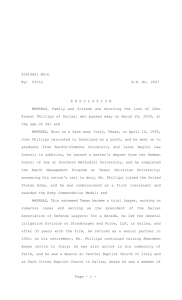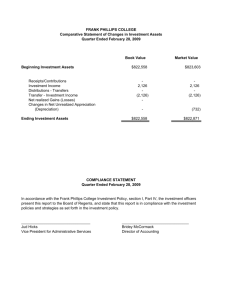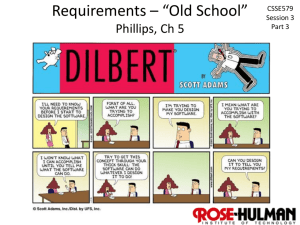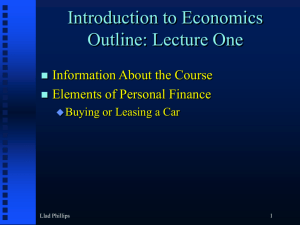Lecture16 - UCSB Economics
advertisement
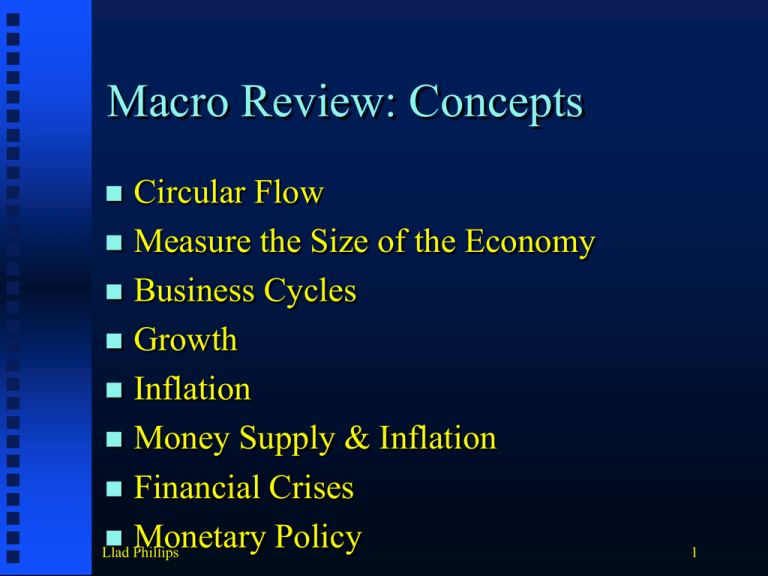
Macro Review: Concepts Circular Flow Measure the Size of the Economy Business Cycles Growth Inflation Money Supply & Inflation Financial Crises Monetary Policy Llad Phillips 1 Circular Flow Identifies actors: consumers & firms Llad Phillips 2 Expenditure Perspective: Open Firms Exports (Sales) Supply Goods Demand Goods Imports (puchases) Households Government Households: Consumption of Goods and Services Firms: Investment in Plant and Equipment Government: Purchase of Goods and Services All Three: Exports - Imports = Net Exports Llad Phillips 3 Size of the Economy Expenditures Perspective: GDP & Components consumption gross investment government expenditures net exports Llad Phillips 4 Business Cycles Worry: Underutilized Resources unemployment Cause: Not enough spending consumer fear: lack of confidence in economy business owners fear: lack of consumer demand Llad Phillips 5 Less than Full Employment Equilibrium Consumption, C GDP = C + I Investment, I GDP C = C0 + mpc* Y I 450 GDP = Y Llad Phillips Full Employment Income YFE Income, Y 6 Growth in Size of the Economy Welfare increases with output per worker output per worker increases with: capital deepening technological progress Llad Phillips 7 Inflation percentage rate of increase in prices (index) price index for a market basket of goods, relative to a base year cost Llad Phillips of basket in 1998/cost in 1990(base year) 8 Cause of Inflation Too much money chasing too few goods Quantity Theory of Money money Llad Phillips supply*velocity = price index*real GDP 9 Financial Crises Liquidity Crisis: run on the banks Solvency Crisis: bad bank loans Llad Phillips 10 Monetary Policy Goals full employment price stability interest rate stability Tools or instruments open market operations discount rate reserve requirement Llad Phillips 11 Introduction to Economics Microeconomics The US Economy Llad Phillips 12 Outline: Lecture Sixteen The Distribution of National Income by Input Factor Shares The Distribution of Personal Income Trends in US Income Inequality Poverty Llad Phillips 13 National Income 1996 Corporate Profits Rental Income11% Net Interest 7% 2% Proprietor's Income 9% Employee Compensation 71% source: Lecture Six US National Income: Factor Shares, 1929-1965 . Rent to Persons Net Interest 100% Corporate Profits 80% Proprietor’s Income 40% Employee Compensation 2/3 capital, land, entrepreneurship 1/3 20% Year Llad Phillips 15 65 63 61 59 57 55 53 51 49 47 45 43 41 39 37 35 33 31 0% 29 Percent 60% If workers are paid a real wage equal to their marginal product of labor, and other factors of production are paid their marginal product of production, does not everybody get their just desserts? Llad Phillips 16 Defense of the Status Quo If the economy has constant returns to scale, If labor is paid its marginal product, If capital receives its marginal product, Income paid to labor & capital = output Everybody is paid what the are worth and there is no exploitation MERITOCRACY Llad Phillips 17 Variation of Personal Income The Distribution of Income California Income 1993 Number of tax returns by adjusted gross income (AGI) class US Llad Phillips Income 18 California: Adjusted Gross Income, 1993 Tax Year . 300000 250000 150000 100000 50000 Adjusted Gross Income Source: California Statsitical Abstract . 30000 28000 26000 24000 22000 20000 18000 16000 14000 12000 10000 8000 6000 4000 2000 0 0 Number 200000 California: Number of Returns by Adjusted Gross Income, T ax Year 1993 . 3000000 2500000 1500000 1000000 500000 Adjusted Gross Income Llad Phillips 100000 90000 80000 70000 60000 50000 40000 30000 20000 0 10000 Number 2000000 . 20 CA AGI, Frequency & Cumulative Frequency Income < 10,000 10-20,000 20-30,000 30-40,000 -50,000 -100,000 -150,000 -200,000 -300,000 -400,000 -500,000 -1,000,000 Number Frequency Cumulative 2727672 22.86% 22.86 2440167 20.45% 43.31 1802873 15.11% 58.42 1305679 10.94% 69.36 997933 8.37% 77.73 2107160 17.66% 95.39 323390 2.71% 98.10 102863 0.86% 98.96 70848 0.59% 99.55 23982 0.20% 99.75 11661 0.10% 99.85 17172 0.14% 99.99 Distribution of Adjusted Gross Income, California . 0.25 0.15 0.1 0.05 100000 90000 80000 70000 60000 50000 40000 30000 20000 10000 0 0 Frequency 0.2 Income Llad Phillips 22 Llad Phillips Income 23 1000000 500000 400000 300000 200000 150000 100000 90000 80000 70000 60000 50000 40000 35000 30000 25000 20000 15000 10000 5000 Probability Cumulative Distribution of California Adjusted Gross Income . 1 0.9 0.8 0.7 0.6 0.5 0.4 0.3 0.2 0.1 0 Measures of Income Inequality Lorenz Curve What % of Population Has What % of Income Gini Coefficient • range: 0, meaning equal, to 1, meaning unequal Examples socialist ideal: equality life as a crap shoot: any income is equally likely Llad Phillips 24 Frequency for Equal Distribution of Income . Cumulative Frequency: Equal Distribution 0.1 1 0.09 0.9 $33000 0.08 0.07 0.8 0.7 0.06 0.05 Probability 0.04 0.03 0.6 0.5 0.4 0.02 0.3 0.01 0.2 0.1 100000 100000 95000 90000 85000 80000 75000 70000 65000 60000 55000 50000 45000 40000 35000 30000 25000 20000 15000 Income 10000 0 0 95000 90000 85000 80000 75000 70000 65000 60000 55000 50000 45000 40000 35000 30000 25000 20000 15000 10000 0 5000 0 5000 frequency . Income Lorenz Curve: Equal Distribution of Income . 100 0 20 40 60 80 95 100 % Income 90 0 20 40 60 80 95 100 80 70 % Income % Population 60 50 40 30 20 10 0 0 20 40 % Population 60 80 100 Frequency Distribution for the Uniform . Cumulative Frequency for Uniform Distribution 1 0.01 0.8 Probability 0.008 0.006 0.004 0.002 0 0.6 0.4 0.2 Income 0 20 40 60 80 95 100 98000 91000 84000 77000 70000 63000 56000 49000 Income Uniform Lorenz Curve for Uniform Distribution 0 4 16 36 64 90.25 100 . 100 Gini Coefficient = A/(A+B) 80 % Income % Population 42000 35000 28000 21000 14000 0 96000 88000 80000 72000 64000 56000 48000 40000 32000 24000 16000 8000 0 0 7000 Frequency . 60 A 40 B 20 0 0 20 40 60 % Population 80 100 US Family Income, 1994 % Families % Income 0 0 20 4.2 40 14.2 60 29.9 80 53.2 95 79.9 100 100 Lorenz Curve: United States Families, 1994 . 100 90 80 % Income 70 60 50 40 30 Equal Uniform Family 20 10 0 0 Source: US Statistical Abstract 20 40 60 % Families 80 100 Frequency Distribution for the Exponential . . Cumulative Frequency for Exponential 0.03 . 1 0.9 0.025 0.8 Probability 0.7 0.015 0.01 0.6 0.5 0.4 0.3 0.005 0.2 0.1 95000 % POP 0 0.00467884 0.0175231 0.02649902 0.06155194 0.09020401 0.17335853 0.26424112 0.4421746 0.59399415 0.80085173 0.90842181 1 100000 95000 90000 85000 80000 75000 70000 65000 60000 55000 Lorenz Curve: Exponential Distribution . 1 0.9 0.8 0.7 Percent Income 0.09516258 0.18126925 0.22119922 0.32967995 0.39346934 0.52763345 0.63212056 0.77686984 0.86466472 0.95021293 0.98168436 50000 Income % Income 0 45000 40000 35000 30000 25000 20000 15000 10000 Income 5000 0 0 90000 85000 80000 75000 70000 65000 60000 55000 50000 45000 40000 35000 30000 25000 20000 15000 10000 5000 0 0 Frequency 0.02 0.6 0.5 0.4 0.3 0.2 0.1 0 1 0 0.2 0.4 0.6 Percent Population 0.8 1 Distribution of Adjusted Gross Income, California . 0.25 0.15 0.1 0.05 100000 90000 80000 70000 60000 50000 40000 30000 20000 10000 0 0 Frequency 0.2 Income Llad Phillips 29 Why is Income Distributed So Unevenly? Labor Income is Unevenly Distributed Part-time work less than 50 weeks per year less than 36 hours per week Llad Phillips 30 “A rising tide lifts all boats”, JFK Economic growth may make everbody better off increases but the size of the pie the rich may get a larger share of the bigger pie It is possible that the rich get richer and the poor get poorer Llad Phillips 31 Income Distribution and GDP Per Capita Source: United Nations Development Programme, Human Development Report, 1993 Country GDP Per Income Share: Gini Capita, Lowest 40%, Coefficient 1990* Families Singapore Hong Kong Malaysia Mexico Brazil Jamaica Honduras $15,580 $15,595 15% 16.2% 0.42 0.45 $6,140 $5,918 $4,718 $2,979 $1,470 13.9% 0.48 0.50 0.57 0.66 0.62 8.1% 15.3% * purchasing power parity Llad Phillips 32 . Lorenz Curves: US Famiy Income, 1970, 1980, 1994 . 100 90 80 % Income 70 60 50 40 30 1970 1980 1994 20 10 0 0 20 40 60 80 100 % Families Llad Phillips 33 Trends In US Family Income Shares, . Top 5%, Top 20%, Bottom 40% 50 45 40 % Income 35 30 25 20 15 10 5 Top 5 % Top 20 % Bottom 40% 0 1970 1975 1980 1985 1990 1995 % Families Llad Phillips 34 Trends In US Median Family Income, 1994 $ . 45000 40000 35000 1994 $ 30000 25000 20000 15000 10000 5000 0 1970 1975 1980 1985 1990 1995 Year Llad Phillips 35 Why has income become more unevenly distributed? Standardize on Male Full-Time YearAround Workers Ability Premium 90 percentile: $70314 for 1995 males 50 percentile: $31497 10 percentile: $12920 Education Premium college grads gain relative to high school grads Experience Premium 36 older workers gain relative to younger workers Llad Phillips Earnings Ratios for Male High School Graduates . 2.5 2 Ratio 1.5 1 90/50 ratio 50/10 ratio 0.5 1995 1993 1991 1989 1987 1985 1983 1981 1979 1977 1975 1973 1971 1969 1967 0 Year Llad Phillips Source: Economic Report of the President, 1997 37 Ratio of Median Earnings, Males: College Grad to High School Grad Source: Economic Report of the President, 1997 Llad Phillips 38 Ratio of Median Earnings, Males: Age 45-54 to 25-34 Llad Phillips Source: Economic Report of the President, 1997 39 Growing Wage Differentials Between the Less Skilled and More Skilled: Less Demand for Less Skilled and More Demand for the More Skilled Llad Phillips Source: Economic Report of the President, 1997 40 Rich Are Getting Richer smart are getting richer educated are getting richer experienced are getting richer Should we worry about the dull, the ignorant, the young and inexperienced? Llad Phillips 41 Poverty in the US US Government Definition of Poverty Subsistence wage: $15141 in 1994 a non-farm family of four cost of inexpensive but nutritious food times 3 • assume food is 1/3 of budget Trends in Poverty Incidence of Poverty elderly children/families headed by single women rural Llad Phillips 42 Llad Phillips 43 Incidence of Poverty Among the Aged and the Young Children: 14.9% in 1970 to 21.2% in 1994 Llad Phillips Source: Economic Report of the President, 1997 44 Llad Phillips 45 Percentage of Births Occuring Out of Wedlock, . White Women by Age Group, US . 35 15-19 20-24 25-29 30 Percent 25 20 15 10 5 0 1955 1960 1965 1970 1975 1980 Year Llad Phillips 46 Percentage of Births Occurring Out of Wedlock, . Black Mothers By Age Group, US 90 15-19 20-24 25-29 80 70 Percent 60 50 40 30 20 10 0 1955 1960 1965 1970 1975 1980 Year Llad Phillips 47 US Families Headed By Women in Percent . 45 40 35 White Black Percent 30 25 20 15 10 5 0 1940 1950 1960 1970 1983 Year Llad Phillips 48 Marriage and Divorce Rates Per 1000 Population, US . 12 10 Marriages Divorces 6 4 2 1992 1989 1986 1983 1980 1977 1974 1971 1968 1965 1962 1959 1956 1953 0 1950 Rate 8 Year Llad Phillips 49 US Marrige Rates Per 1000 Population, . Unmarried Women 15-44 Years Old 160 140 120 80 60 40 20 1994 1992 1990 1988 1986 1984 1982 1980 1978 1976 1974 1972 0 1970 Rate 100 Year Llad Phillips 50 Summary-Vocabulary-Concepts input factor shares distribution of personal income distribution of family income frequency distribution of income cumulative distribution of income Lorenz curve Gini coefficient median family income Llad Phillips part-time, part-year worker full-time, full-year worker within group variation in earnings ability differential between group variation in earnings education differential experience differential definition of poverty 51
